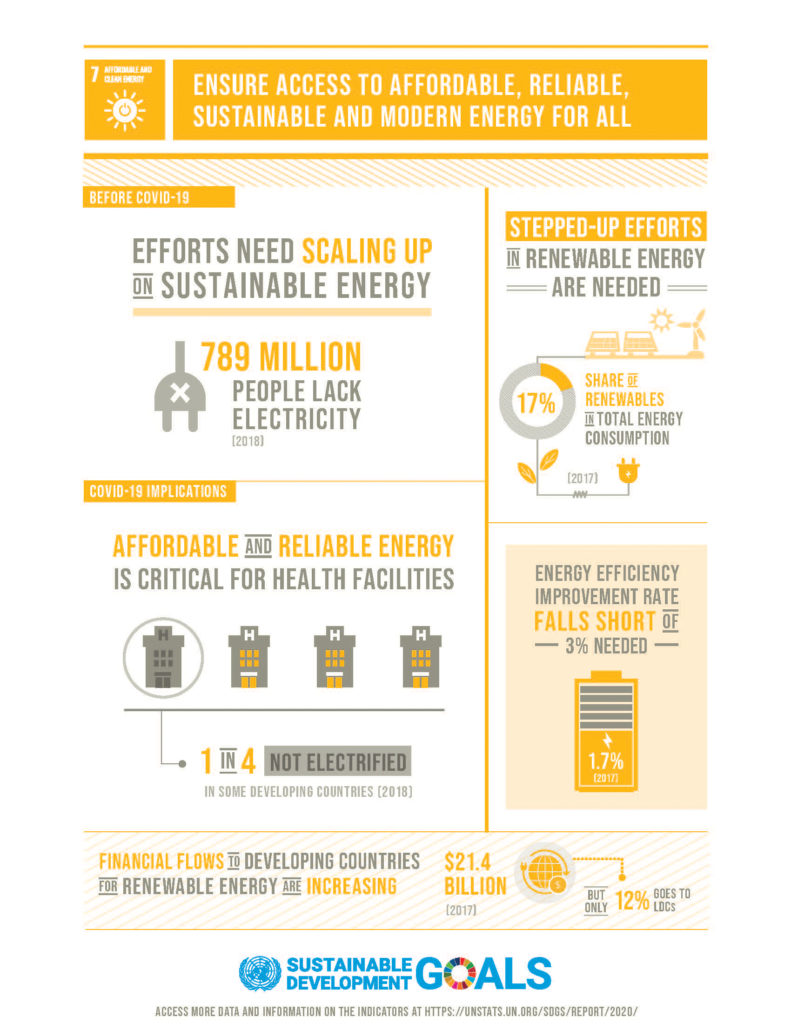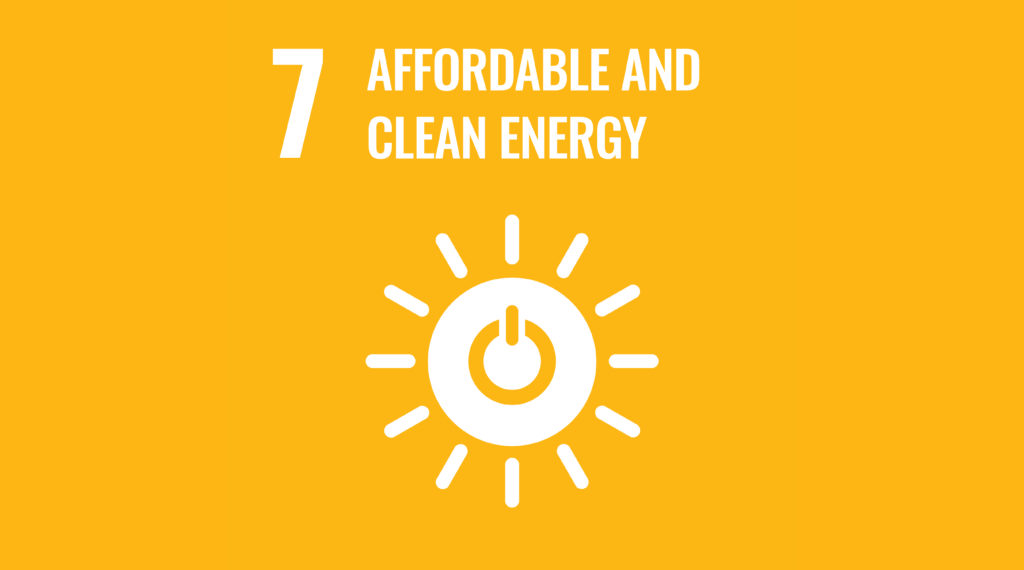Clean Energy
The world is making progress towards Goal 7, with encouraging signs that energy is becoming more sustainable and widely available. Access to electricity in poorer countries has begun to accelerate, energy efficiency continues to improve, and clean energy is making impressive gains in the electricity sector.
Nevertheless, more focused attention is needed to improve access to clean and safe cooking fuels and technologies for 3 billion people, to expand the use of renewable energy beyond the electricity sector, and to increase electrification in sub-Saharan Africa.
The Energy Progress Report provides global dashboard to register progress on energy access, energy efficiency and clean energy. It assesses the progress made by each country on these three pillars and provides a snapshot of how far we are from achieving the 2030 Sustainable Development Goals targets.
Sustainable Development Goals
The 2030 Agenda for Sustainable Development was adopted by all United Nations Member states in 2015, an agenda that provides a shared blueprint for peace and prosperity for people and the planet, now and into the future.
The 17 Sustainable Development Goals (SDGs) are an urgent call for action by all countries – developed and developing – in a global partnership. They recognize that ending poverty and other deprivations must go hand-in-hand with strategies that improve health and quality education, reduce inequality, and spur economic growth – all while tackling climate change and working to preserve our oceans and forests. Learn more about the UN SDG’s.

What’s the goal here?
To ensure access to affordable, reliable, sustainable and modern clean energy for all.
Why?
A well-established energy system supports all sectors: from businesses, medicine and education to agriculture, infrastructure, communications and high-technology. Access to electricity in poorer countries has begun to accelerate, energy efficiency continues to improve, and clean energy is making impressive gains. Nevertheless, more focused attention is needed to improve access to clean and safe cooking fuels and technologies for 2.8 billion people.
Why should I care about this goal?
For many decades, fossil fuels such as coal, oil or gas have been major sources of electricity production, but burning carbon fuels produces large amounts of greenhouse gases which cause climate change and have harmful impacts on people’s well-being and the environment. This affects everyone, not just a few. Moreover, global electricity use is rising rapidly. In a nutshell, without a stable electricity supply, countries will not be able to power their economies.
How many people are living without electricity?
Nearly 9 out of 10 people now have access to electricity, but reaching the unserved 789 million around the world – 548 million people in sub-Saharan Africa alone – that lack access will require increased efforts. Without electricity, women and girls have to spend hours fetching water, clinics cannot store vaccines for children, many schoolchildren cannot do homework at night, and people cannot run competitive businesses. Slow progress towards clean cooking solutions is of grave global concern, affecting both human health and the environment, and if we don’t meet our goal by 2030, nearly a third of the world’s population – mostly women and children – will continue to be exposed to harmful household air pollution.
What are the consequences to lack of access to energy?
Lack of access to energy may hamper efforts to contain COVID-19 across many parts of the world. Energy services are key to preventing disease and fighting pandemics – from powering healthcare facilities and supplying clean water for essential hygiene, to enabling communications and IT services that connect people while maintaining social distancing.
What can we do to fix these issues?
Countries can accelerate the transition to an affordable, reliable, and sustainable energy system by investing in renewable energy resources, prioritizing energy efficient practices, and adopting clean energy technologies and infrastructure.
Businesses can maintain and protect ecosystems and commit to sourcing 100% of operational electricity needs from renewable sources.
Employers can reduce the internal demand for transport by prioritizing telecommunications and incentivize less energy intensive modes such as train travel over auto and air travel.
Investors can invest more in sustainable energy services, bringing new technologies to the market quickly from a diverse supplier base.You can save electricity by plugging appliances into a power strip and turning them off completely when not in use, including your computer. You can also bike, walk or take public transport to reduce carbon emissions.
United Nation Sustainable Development Goals
(United Nations why it matters)
Facts and Figures
- 13per cent of the global population still lacks access to modern electricity.
- 3 billion people rely on wood, coal, charcoal or animal waste for cooking and heating
- Energy is the dominant contributor to climate change, accounting for around 60 per cent of total global greenhouse gas emissions.
- Indoor air pollution from using combustible fuels for household energy caused 4.3 million deaths in 2012, with women and girls accounting for 6 out of every 10 of these.
- In 2016, the share of renewables increased at the fastest rate since 2012, up 0.24 percentage points, and reached almost 17.5per cent owing to rapid growth in hydropower, wind, and solar.
Goal 7 Targets
- 7.1 By 2030, ensure universal access to affordable, reliable and modern energy services
- 7.2 By 2030, increase substantially the share of renewable energy in the global energy mix
- 7.3 By 2030, double the global rate of improvement in energy efficiency
- 7.A By 2030, enhance international cooperation to facilitate access to clean energy research and technology, including renewable energy, energy efficiency and advanced and cleaner fossil-fuel technology, and promote investment in energy infrastructure and clean energy technology
- 7.B By 2030, expand infrastructure and upgrade technology for supplying modern and sustainable energy services for all in developing countries, in particular least developed countries, small island developing States, and land-locked developing countries, in accordance with their respective programmes of support
Links:
Sustainable Energy for All initiative
UNIDO Energy and Climate Change
International Renewable Energy Agency
We, at AI for Good foundation, are using AI + ML initiatives in pursuit of the 17 SDGs. With various projects in progress, such as our Climate Trend Scanner and the SDG Data Catalog, we are determined to help and facilitate achieving the goals.







